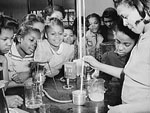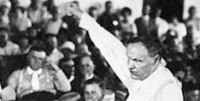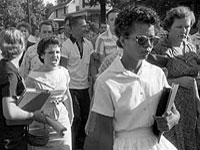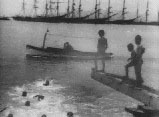The Bray School
Headmistress Ann Wager taught at the Bray School in Williamsburg, VA, from 1760 to 1774, educating enslaved children. Interpreter Antoinette Brennan shares details from Wager's life and describes the school and its operations.
Headmistress Ann Wager taught at the Bray School in Williamsburg, VA, from 1760 to 1774, educating enslaved children. Interpreter Antoinette Brennan shares details from Wager's life and describes the school and its operations.
The Elgin Schoolhouse is a historic school in rural Nevada's Lincoln County. The schoolhouse was used from 1922 through 1967, when its last student reached eighth grade. Today, the Elgin Schoolhouse State Historic Site features half of the house's original items. The rest are authentic to the time period.
The site offers exhibits and tours.
One of America's highest ranked military officers, Gen. John J. "Black Jack" Pershing, spent most of his childhood years in the small town of Laclede. Pershing was born Sept. 13, 1860, and moved into the Gothic nine-room house in Laclede with his family at age six. He taught at Prairie Mound School, and in 1886, graduated from the U. S. Military Academy at West Point, thus beginning his military career. Between 1886 and his military retirement in 1924, Pershing fought his way up through the military ranks. In 1917, Pershing was sent to France as Commander-in-Chief of the American Expeditionary Forces in World War I and two years later was named General of the Armies of the United States by a special act of Congress. Today, visitors can tour Gen. Pershing's boyhood home. A statue of "Black Jack" stands next to the home surrounded by granite tablets naming war veterans. Inside Prairie Mound School, an exhibit gallery allows visitors to walk through the many doorways Gen. Pershing passed through during his childhood life, military career, and numerous accomplishments.
The site offers a short film, exhibits, and tours.
The Grant Boyhood Home was the home of Ulysses S. Grant, 18th president of the United States, from 1823, when Grant was one year old, until 1839, when he left to attend West Point. Ulysses Grant lived in this home longer than any other during his lifetime. Jesse and Hanna Grant, the parents of young Hiram Ulysses Grant, built the original two-story brick section of the Grant Boyhood home in 1823, when they moved to Georgetown from Point Pleasant in Clermont County, where Ulysses had been born the year before. Grant attended the Schoolhouse from the ages of about six to 13. The building, built in 1829, consisted of only one room at that time.
The site offers tours.

For a time early in my teaching career, I lived in the historically black neighborhood in St. Augustine, FL, known as Lincolnville, which had been the home to prominent black civil rights leaders Henry and Katherine "Kat" Twine as well as the location of several stops by Martin Luther King, Jr. during the 1950s and 1960s. About three blocks from my house was the Excelsior School which served black students from the neighborhood and surrounding areas from the early 20th century to the late 1960s. I passed by the building every day on my way to teach history at a high school some 30 years after integration. After living in the neighborhood, I learned that the Excelsior building had ceased operation as a school after the 1967–68 school year when its students were finally integrated. The state took over the building some time after and used it for offices during the 1980s, but it was vacant for much of the decade before I moved into the area.
I had an idea to use a room or two in the building to provide some after-school tutoring. You see, several of my students lived in this neighborhood. Some had struggled academically and a few had dropped out. I would see them, unemployed and idle on the streets at all hours. This neighborhood, which had seen hard times economically and socially since its heyday in the 1950s as an African American business hub was, by then, riddled with drugs and occasional violence. My goal was to operate a class to prepare my former students and any other neighbors for a high school diploma through the GED test. In my search for access to this historic building I learned that a former teacher and school board member was just beginning the process of renovating the property to become a museum and cultural center for the neighborhood. As I began the program, I learned more about the school and the education its teachers provided. I learned that many prominent black leaders were educated at this school. I learned that (when allowed) this school not only competed favorably with surrounding white schools in athletics, but academics as well. The artifacts, including photographs, newspaper articles, and yearbooks that were being gathered for the museum, presented a vibrant school with classroom and hallway walls covered in empowering posters and exemplary student work, a decorated debate team, Latin club, and more.
As a history teacher I was intrigued. The narrative of segregated education as presented in the textbook I used showed none of this. In my undergraduate studies in history education, I learned little beyond the traditional narrative. My students came away from my classroom with the idea that, without qualification, black schools were inferior, and I was complicit in their misunderstanding. The message was that only with integration were black students given the opportunity to get a quality education. I realized that this message failed to dig deep enough. It failed to present the complexities that existed in these disparate systems, to recognize the education that was occurring in spite of remarkable challenges. Students need opportunities to challenge the traditional narrative, and this topic is well suited to illustrate that opportunity.
Since my time at Excelsior, I have had the opportunity to talk with some former students, teachers, and administrators who shared stories from their time there. What I found from these interviews echoed the themes discovered by Vanessa Siddle Walker in her extraordinary meta-analysis of articles related to segregated schools from the Fall 2000 issue of the American Educational Research Association journal. Her findings showed that schools in segregated communities were not only centers of education but also often fundamental to neighborhood cohesiveness. Along with fostering nurturing learning environments with high academic expectations, these schools often served as community centers, social gathering places, and information hubs.
In the interest of presenting our students with a more inclusive history, teachers can presents sources to students that challenge the idea that the black community was incapable of providing quality education to their students and that only through integration into the white school system were black students able to receive a worthwhile education. With review of articles such as Siddle Walker's, teachers themselves can become more knowledgeable about the historiography of segregated education beyond the traditional narrative. Through examination of web resources from the Library of Congress, the National Archives, and others, teachers can show that even in the face of inadequate facilities and tremendous societal discrimination, many of these schools educated generations of future teachers, doctors, lawyers, civil rights leaders, and informed and active democratic citizens with constructive learning environments and challenging curriculum. For instance, "Education Resources on School Desegregation" on the National Archives website provides useful resources as well as implementation ideas and strategies for the classroom.
Allowing students the chance to discover sources for themselves, which open up this more nuanced paradigm, can also serve as an entry into this topic and provide experience in moving beyond the textbook when examining the past. Students may begin by using keywords such as "segregation and education" in the Library of Congress site to get started in their search to challenge the traditional narrative of African American education.
The notion that a segregated school system is moral or even tenable is nonsensical. Schools that educated black children during the Jim Crow era struggled with inferior facilities and resources. However, in the spirit of good history, teachers have an opportunity, within the theme of racial segregation, to challenge the traditional narrative that separate and unequal education extended to the abilities and desires of teachers, administrators, and parents to provide their students with quality education.
Walker, Vanessa Siddle. "Valued Segregated Schools for African American Children in the South, 1935-1969: A Review of Common Themes and Characteristics." Review of Educational Research 70:3 (Fall 2000): 253-285.
Links to Siddle Walker's abstract as well as other full-text articles related to the segregated school experience.
Walker, Vanessa Siddle. "Dr. Emilie Vanessa Siddle-Walker." Caswell County Historical Association. Accessed June 2, 2011.
Siddle Walker's biography with several references.
Morris, Jerome. "Research, Ideology, and the Brown Decision: Counter-narratives to the Historical and Contemporary Representation of Black Schooling." 2008. Teachers College Record. Accessed 2 June, 2011.http://www.tcrecord.org/Content.asp?ContentID=14616
Jerome Morris's Teachers College Record article.
This American Association of Colleges for Teacher Education (AACTE) curriculum guide and PBS website include some material on segregated schools.
The Library of Congress looks at the history of segregated schools— as does the National Archives—and you can find more about Brown vs. Board with a quick search of our site.
The museum collects, preserves, interprets, and displays historical and cultural materials related to the westward expansion, to Wyoming pioneers in particular, and to the west in general. Today, the 15,900-square-foot facility consists of the main building as well as the original cabin, two school houses, a rebuilt gristmill, and a shelter. The collections include pioneer and ranching memorabilia, textiles, and an extensive Native American artifact and decorative art display.
A second website for the museum can be found here.
The museum offers exhibits, research library access, and occasional recreational and educational events.
Formed in 1962, the Rocky Hill Historical Society's first mission was to save the Academy Hall. The Hall was built in 1803 as a navigation school to teach young sailors and future sea captains. Today the town's history is accessible to the public through the museum, library, and programs located in Academy Hall. The library contains book collections, manuscripts, stories, oral histories, photographs, and maps, and is open for research. The Academy Hall Museum displays artifacts, farm implements, military items, maritime history, technology, and costumes.
The museums offers exhibits and research library access.

Four guided investigations designed to teach students how to read primary sources and construct historical narratives lie at the heart of this website. Topics are: the Spanish-American War, the Scopes Trial, Social Security, and Rosa Parks. Each topic includes a short introductory video, a timeline of events, a central question, and extension activities. For example, the Rosa Parks investigation poses the question: "Why did the boycott of Montgomery's buses succeed?"
After completing a simple login, students read annotated documents—including letters written by the boycott organizers, a speech by Martin Luther King, Jr. and an interview with a woman working in Montgomery—and answer guiding questions, and draw on their responses to answer the question. The website also includes a useful introduction to the idea of historical thinking.

This collection of newspaper articles and photographs from two Arkansas newspapers explores the 1957 crisis in the city of Little Rock. National attention focused on the city when Governor Orval Faubus refused to allow nine African American students to desegregate the city's all-white Central High School, despite federal court rulings to the contrary. In response, President Dwight D. Eisenhower reluctantly became the first president since Reconstruction to send federal troops to protect the rights of African Americans.
Materials include news articles and editorials from each day of the month-long crisis, articles on the anniversaries from 1997 to 2000, and 16 photographs. In addition, material on the 40th anniversary of the crisis is provided: 19 op-ed pieces, speeches, an interview with President Clinton, timelines, and a 1991 defense by Faubus of his actions.

This collection of 150 motion pictures produced between 1894 and 1915 deals with work, school, and leisure activities in the U.S. The films include footage of the U.S. Postal Service in 1903, cattle breeding, firefighters, ice manufacturing, logging, physical education classes, amusement parks, sporting events, and local festivals and parades. Each film is accompanied by a brief summary.
A special presentation furnishes additional information on three categories: America at school, work, and leisure. Essays of roughly 1,000-words provide context and general descriptions of films in each category, display 15 illustrative photographs, and link to related films. A 31-work bibliography provides suggestions for further reading and websites on American labor, education, and leisure.